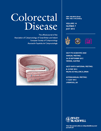Biological implants in sphincter augmentation offer a good short-term outcome after a sphincter repair
Funded by the Department of Colorectal Surgery, Cleveland Clinic Foundation, Cleveland, Ohio, USA. Poster presentation at the Annual Meeting of the American College of Surgeons, Minneapolis, 15–19 May 2010. Podium presentation at the Annual Meeting of the Association of Coloproctology of Britain and Ireland, 28–30 June 2010.
Abstract
Aim Long-term results of the overlapping sphincter repair (OSR) have been disappointing, attributed to poor tissue quality that deteriorates with time. Biological grafts enforce tissues. The aim was to compare functional outcome and quality of life at 1 year with and without Permacol® reinforcement to evaluate short-term benefit.
Method From November 2007 to November 2008, women undergoing OSR using Permacol (group 1, n = 10) under institutional review board approval (safety trial) were age matched with patients from an institutional review board approved database (group 2, n = 10) who underwent the traditional OSR. Permacol mesh was placed under the two overlapped muscles. Group 2 underwent traditional repair. Preoperative and postoperative management of the groups was similar. The Fecal Incontinence Severity Index (FISI), the Cleveland Clinic Incontinence Score (CCFIS) and the Fecal Incontinence Quality of Life (FIQL) scale were used preoperatively and 1 year post-surgery.
Results No significant differences in demographics, symptom duration, number of vaginal deliveries, comorbidities and symptom severity were noted. Group 2 underwent concomitant procedures. Group 1 reported no complications. Group 2 reported urinary retention and dehiscence. A significant difference was found in preoperative and postoperative FIQL subscales of coping/behaviour between groups. However, comparing the pre and post scores, significant improvements on FISI (P = 0.02), the CCFIS (P = 0.005) and two subscales of FIQL (coping/behaviour, P = 0.02, and embarrassment, P = 0.01) were found in group 1. Patient satisfaction was higher in group 1.
Conclusion Biologic tissue enhancers (Permacol) do not add morbidity. Sphincter augmentation results in significant improvement in continence and quality of life scores compared with the preoperative scores in the short term over traditional repair. Long-term studies are needed to determine if this effect is sustained.




